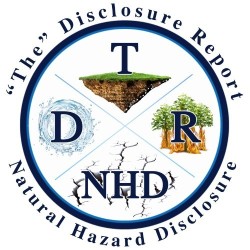What is a Natural Hazard Disclosure (NHD) Report and How Do They Protect Home Buyers?
When purchasing a home, it’s not just about the price, location, or curb appeal; understanding the potential risks associated with a property is equally crucial. Natural Hazard Disclosure (NHD) reports, such as those provided by TDRNHD, play a vital role in real estate transactions by offering essential information about external hazards that could impact a property's value, safety, or future insurability. For home buyers and real estate agents alike, understanding the importance of these reports is key to effective real estate risk management and home buyer protection.
What is a Natural Hazard Disclosure (NHD) Report?
Natural Hazard Disclosure reports are comprehensive documents that outline specific natural hazards that could affect a property. Required by law in California, and recommended in all other states, NHD reports help ensure full transparency in real estate transactions. These reports detail whether a property is located in a hazard zone such as a floodplain, earthquake fault line, high fire risk area, or landslide zone.
NHD reports are a critical part of real estate risk management. They allow potential buyers to understand the risks associated with a property, enabling them to make informed decisions. By being fully aware of these risks, buyers can negotiate pricing, insurance policies, and plan for any necessary mitigations.
Why are NHD Reports Important in Real Estate Transactions?
The importance of NHD reports in real estate transactions cannot be overstated. Buying a home is one of the most significant investments a person can make, and unforeseen risks can have both financial and safety implications. Here’s why NHD reports, like those from TDRNHD, are indispensable:
- Identifying External Hazards: Most home buyers are unaware of the potential hazards lurking in and around a property. NHD reports reveal whether a property is in a designated flood zone, within a proximity to an earthquake fault line, or susceptible to wildfire risks. For instance, a home in a flood zone might require additional flood insurance, which could be a significant cost factor.
- Providing Peace of Mind for Buyers: Knowing the potential risks in advance offers peace of mind. When buyers receive an NHD report, they gain a comprehensive understanding of natural hazards that may affect their new home. This allows them to weigh the benefits and potential downsides, ensuring that there are no surprises after the purchase is finalized.
- Enabling Informed Decision-Making: With the insights provided by an NHD report, buyers can make more informed decisions regarding their potential purchase. They can consider how the risks might impact the property’s value over time, future resale potential, and insurance requirements. Understanding these elements can even give buyers leverage during price negotiations.
- Guiding Insurance Considerations: An NHD report highlights specific hazards, which directly impacts insurance costs and coverage. For example, properties in high-risk fire or earthquake zones may need specialized insurance. Understanding these requirements ahead of time helps buyers avoid unexpected costs and ensures they have the necessary protection in place.
How TDRNHD Reports Help Mitigate Real Estate Risks
The process of risk mitigation begins with understanding the potential dangers associated with a property. TDRNHD reports provide real estate agents and home buyers with detailed, localized information about natural hazards. Here are a few ways NHD reports help mitigate real estate risks:
- Risk Assessment and Reduction: Once a natural hazard is identified, buyers can take steps to reduce their exposure. For example, if a property is within a flood zone, buyers might install flood barriers or invest in additional drainage solutions. Similarly, homes near wildfire-prone areas might benefit from defensible space strategies, such as clearing vegetation and using fire-resistant materials.
- Informed Investment Decisions: Knowing the natural hazards associated with a property allows buyers to assess whether the investment aligns with their risk tolerance and long-term plans. Some buyers may prioritize properties outside of hazard zones, while others might be willing to take on a higher risk with appropriate preparations and mitigations.
- Transparency and Trust in Real Estate Transactions: For real estate agents, providing NHD reports is an opportunity to build trust and demonstrate their commitment to client protection. By being upfront about potential risks, agents can guide buyers more effectively and ensure that there is no room for future disputes or dissatisfaction. This transparency fosters stronger relationships and establishes agents as knowledgeable and reliable guides in the real estate process.
FAQs About Natural Hazard Disclosure (NHD) Reports
- What exactly is included in a TDRNHD report?
A TDRNHD report provides detailed information on various natural hazards, such as flood zones, earthquake fault lines, high fire-risk areas, and landslide-prone regions. These reports are designed to give potential buyers a comprehensive view of any potential risks that could affect the property.
- How can an NHD report affect my home insurance costs?
If a property is located in a high-risk area, such as a floodplain or wildfire zone, insurance companies may require additional coverage, which could increase your premium. An NHD report helps you understand these risks upfront, allowing you to budget accordingly and seek the best insurance options.
- Do all states require NHD reports for real estate transactions?
Although California is the only state that requires the natural hazard disclosure statement (NHDS) provided in the NHD report from TDRNHD, other states do have requirements to disclose natural hazards associated with properties sold, and they vary by state. It’s essential to check with your real estate agent or legal advisor to understand the specific regulations in your area.
- How do NHD reports benefit real estate agents?
For real estate agents, providing NHD reports from TDRNHD helps demonstrate professionalism and a commitment to transparency. By educating buyers on potential risks, agents can build trust and foster a more informed, confident decision-making process for their clients. In addition, the reports can be ordered without obligation to pay until, and only if, escrow closes. This gives the agent valuable information to overcome objections that may come up based on the result of a report.
By leveraging TDRNHD's comprehensive reports, both home buyers and Realtors can navigate the complexities of real estate transactions with greater confidence, ensuring that every step is backed by accurate, up-to-date information on natural hazards.

